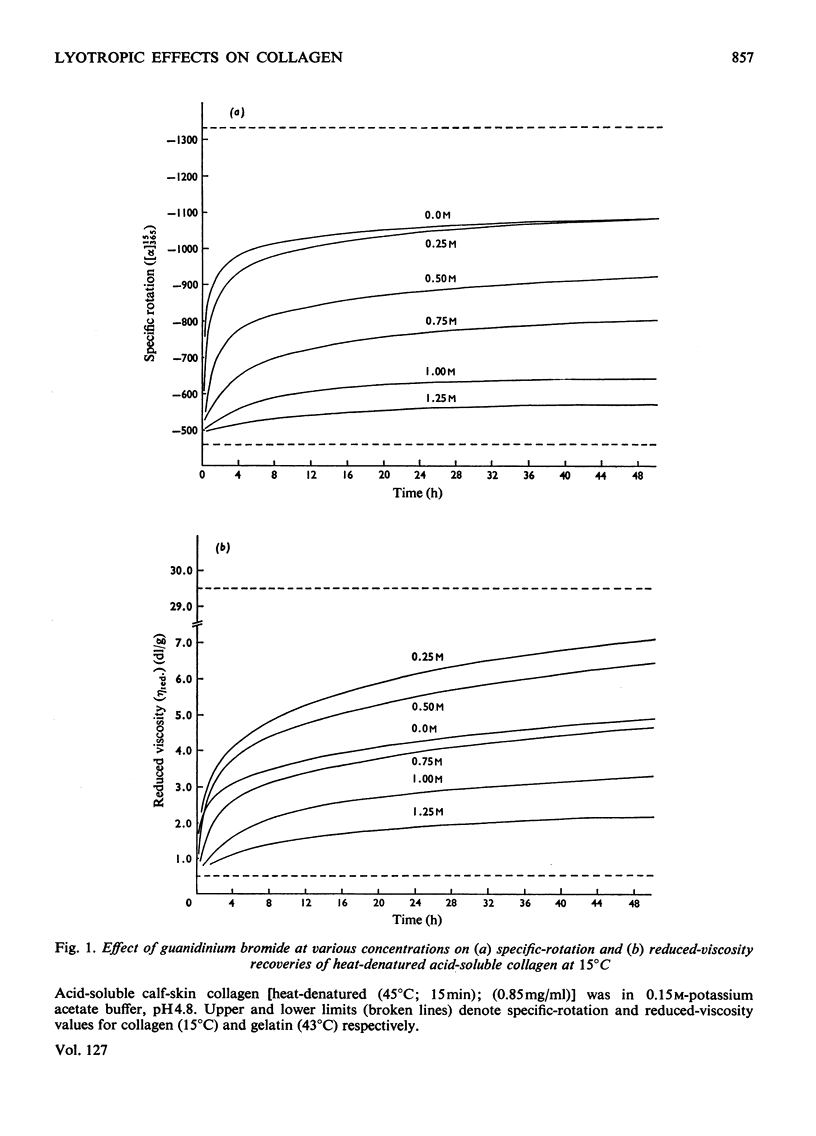Abstract
The effects of guanidinium salts in decreasing the renaturation rate and lowering the thermal stability of acid-soluble calf-skin collagen have been compared with those of formamide and urea. With the exception of guanidinium sulphate at higher concentrations, no qualitative differences were apparent in the effects of these perturbants, which thus differed only in molar activity. Activity variation in the guanidinium salts reflected a net effect resulting from additivity of cation and anion contributions. As observed in other protein systems, lyotropic activity increased in the series formamide<urea<guanidinium ion, and in the guanidinium salts in the anion order fluoride<sulphate<chloride<bromide<nitrate<iodide. Low activities of guanidinium fluoride and sulphate were attributable to counter-effects of the anions, which acted as structural stabilizers. Changes in renaturation kinetics induced by either temperature or added perturbants appeared to conform with the Flory–Weaver model for the collagen transition. Additivity and non-specificity of the observed effects are discussed with particular reference to a common mechanism involving weak, non-saturated binding of perturbants at protein peptide groups.
Full text
PDF








Selected References
These references are in PubMed. This may not be the complete list of references from this article.
- BELLO J., BELLO H. R., VINOGRAD J. R. The functional groups in the gelation of gelatin. Biochim Biophys Acta. 1962 Feb 26;57:222–229. doi: 10.1016/0006-3002(62)91114-9. [DOI] [PubMed] [Google Scholar]
- Beier G., Engel J. The renaturation of soluble collagen. Products formed at different temperatures. Biochemistry. 1966 Aug;5(8):2744–2755. doi: 10.1021/bi00872a035. [DOI] [PubMed] [Google Scholar]
- CLELAND W. W. Computer programmes for processing enzyme kinetic data. Nature. 1963 May 4;198:463–465. doi: 10.1038/198463a0. [DOI] [PubMed] [Google Scholar]
- Castellino F. J., Barker R. The denaturing effectiveness of guanidinium, carbamoylguanidinium, and guanylguanidinium salts. Biochemistry. 1968 Nov;7(11):4135–4138. doi: 10.1021/bi00851a049. [DOI] [PubMed] [Google Scholar]
- Cooper D. R., Davidson R. J. The effect of ultraviolet irradiation on soluble collagen. Biochem J. 1965 Oct;97(1):139–147. doi: 10.1042/bj0970139. [DOI] [PMC free article] [PubMed] [Google Scholar]
- Cooper D. R., Russell A. E., Hart G. J. The effects of glycols on the renaturation of soluble collagen. Biochem J. 1971 Dec;125(4):1069–1074. doi: 10.1042/bj1251069. [DOI] [PMC free article] [PubMed] [Google Scholar]
- Hamaguchi K., Sakai H. Structure of lysozyme. IX. The effect of temperature on the conformation of lysozyme. J Biochem. 1965 Jun;57(6):721–732. doi: 10.1093/oxfordjournals.jbchem.a128138. [DOI] [PubMed] [Google Scholar]
- Harrington W. F., Karr G. M. Collagen structure in solution. II. Analysis of refolding kinetics in terms of nucleation and growth processes. Biochemistry. 1970 Sep 15;9(19):3725–3733. doi: 10.1021/bi00821a011. [DOI] [PubMed] [Google Scholar]
- Hart G. J., Russell A. E., Cooper D. R. The effects of certain glycols, substituted glycols and related organic solvents on the thermal stability of soluble collagen. Biochem J. 1971 Nov;125(2):599–604. doi: 10.1042/bj1250599. [DOI] [PMC free article] [PubMed] [Google Scholar]
- Hauschka P. V., Harrington W. F. Collagen structure in sllution. V. Kinetic mechanism of refolding of cross-linked chains. Biochemistry. 1970 Sep 15;9(19):3754–3763. doi: 10.1021/bi00821a014. [DOI] [PubMed] [Google Scholar]
- KAUZMANN W. Some factors in the interpretation of protein denaturation. Adv Protein Chem. 1959;14:1–63. doi: 10.1016/s0065-3233(08)60608-7. [DOI] [PubMed] [Google Scholar]
- KUEHN K., ENGEL J., ZIMMERMANN B., GRASSMANN W. RENATURATION OF SOLUBLE COLLAGEN. 3. REORGANIZATION OF NATIVE COLLAGEN MOLECULES FROM COMPLETELY SEPARATED UNITS. Arch Biochem Biophys. 1964 May;105:387–403. doi: 10.1016/0003-9861(64)90023-2. [DOI] [PubMed] [Google Scholar]
- MANDELKERN L., STEWART W. E. THE EFFECT OF NEUTRAL SALTS ON THE MELTING TEMPERATURE AND REGENERATION KINETICS OF THE ORDERED COLLAGEN STRUCTURE. Biochemistry. 1964 Aug;3:1135–1137. doi: 10.1021/bi00896a022. [DOI] [PubMed] [Google Scholar]
- Mattice W. L., Mandelkern L. Conformational properties of poly-L-proline form II in dilute solution. J Am Chem Soc. 1971 Apr 7;93(7):1769–1777. doi: 10.1021/ja00736a033. [DOI] [PubMed] [Google Scholar]
- NAGY B., JENCKS W. P. DEPOLYMERIZATION OF F-ACTIN BY CONCENTRATED SOLUTIONS OF SALTS AND DENATURING AGENTS. J Am Chem Soc. 1965 Jun 5;87:2480–2488. doi: 10.1021/ja01089a030. [DOI] [PubMed] [Google Scholar]
- NOZAKI Y., TANFORD C. THE SOLUBILITY OF AMINO ACIDS AND RELATED COMPOUNDS IN AQUEOUS UREA SOLUTIONS. J Biol Chem. 1963 Dec;238:4074–4081. [PubMed] [Google Scholar]
- Russell A. E., Cooper D. R. Enhanced collagen renaturation in the presence of a lyotropic agent. Biochem J. 1969 Jun;113(1):221–223. doi: 10.1042/bj1130221. [DOI] [PMC free article] [PubMed] [Google Scholar]
- Russell A. E., Cooper D. R. Structural and functional factors in the hydrogen bonding of polar organic solvents to acid-soluble collagen. Effect on renaturation kinetics and thermal stability. Biochemistry. 1969 Oct;8(10):3980–3990. doi: 10.1021/bi00838a014. [DOI] [PubMed] [Google Scholar]
- Russell A. E., Cooper D. R. Structural and functional factors in the lyotropic activity of amides and alkyl-substituted amides on acid-soluble collagen. Biochemistry. 1970 Jul 7;9(14):2802–2806. doi: 10.1021/bi00816a008. [DOI] [PubMed] [Google Scholar]
- Tanford C. Protein denaturation. C. Theoretical models for the mechanism of denaturation. Adv Protein Chem. 1970;24:1–95. [PubMed] [Google Scholar]
- Tanford C. Protein denaturation. Adv Protein Chem. 1968;23:121–282. doi: 10.1016/s0065-3233(08)60401-5. [DOI] [PubMed] [Google Scholar]
- VON HIPPEL P. H., WONG K. Y. The effect of ions on the kinetics of formation and the stability of the collagenfold. Biochemistry. 1962 Jul;1:664–674. doi: 10.1021/bi00910a020. [DOI] [PubMed] [Google Scholar]
- VONHIPPEL P. H., WONG K. Y. THE COLLAGEN GELATIN PHASE TRANSITION. I. FURTHER STUDIES OF THE EFFECTS OF SOLVENT ENVIRONMENT AND POLYPEPTIDE CHAIN COMPOSITION. Biochemistry. 1963 Nov-Dec;2:1387–1398. doi: 10.1021/bi00906a035. [DOI] [PubMed] [Google Scholar]
- VONHIPPEL P. H., WONG K. Y. THE COLLAGEN GELATIN PHASE TRANSITION. II. SHAPE OF THE MELTING CURVES AND EFFECT OF CHAIN LENGTH. Biochemistry. 1963 Nov-Dec;2:1399–1413. doi: 10.1021/bi00906a036. [DOI] [PubMed] [Google Scholar]
- Von Hippel P. H., Wong K. Y. On the conformational stability of globular proteins. The effects of various electrolytes and nonelectrolytes on the thermal ribonuclease transition. J Biol Chem. 1965 Oct;240(10):3909–3923. [PubMed] [Google Scholar]
- WILKINSON G. N. Statistical estimations in enzyme kinetics. Biochem J. 1961 Aug;80:324–332. doi: 10.1042/bj0800324. [DOI] [PMC free article] [PubMed] [Google Scholar]


